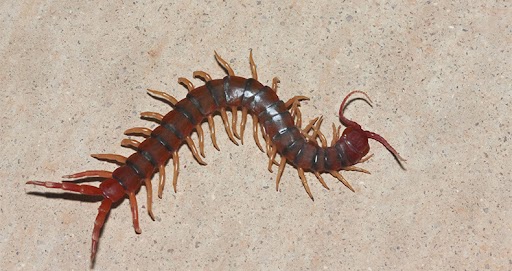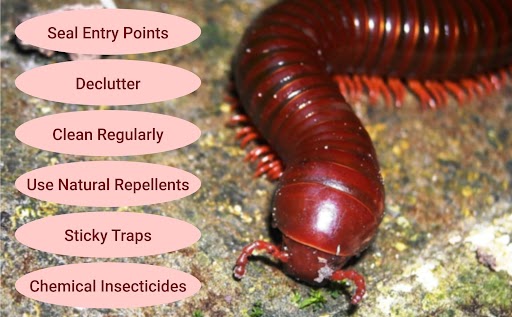Everything You Need To Know About Centipede Infestation & How To Get Rid Of Them?
Published Date: April 2, 2024

Centipedes, belonging to the Chilopoda class, are common arthropods found in moist environments. While they help control insect populations, centipede infestations can threaten property and health. Understanding how to manage and eliminate these pests is crucial for maintaining a comfortable and safe living environment.
How To Identify Centipedes?
Centipedes are elongated arthropods with a distinct appearance that allows for easy identification by pest control professionals and homeowners alike. Here’s a breakdown of their key characteristics:
Features Of Centipedes
- Body: Centipedes have elongated bodies divided into segments, each with a pair of legs.
- Legs: Despite their name (centipede means “100 legs”), they typically have between 15 to 177 pairs of legs, depending on the species.
- Size: They range in size from 4 to 152 mm.
- Color: They can range from yellowish-brown to dark brown or reddish-brown.
- Antennae: Centipedes have long antennae protruding from their heads, which they use to sense their environment.
- Venomous Fangs: Most centipedes possess venomous fangs located on their first body segment, which they use to immobilize and kill prey.
Types Of Centipedes
There are over 3,000 known species of centipedes, but some of the most common ones include:
- House Centipede: These are the most common centipede found in homes. They have yellowish-brown to reddish-brown bodies with 15 pairs of legs. House centipedes are beneficial predators that help control insect populations.
- Desert Centipedes: These are adapted to arid environments and are commonly found in North American desert regions. They have a yellowish-brown coloration and are known for their ability to withstand extreme temperatures and low moisture levels.
Places Where Centipedes Are Normally Found
Centipedes are adept at navigating diverse environments, but their main need is abundant moisture to avoid drying out. This essential requirement governs their preferred habitats.
Outdoor Environments
- Soil and Leaf Litter: Centipedes thrive in the cool, damp microclimates found under decaying logs, leaf litter, and within moist soil. These areas offer excellent hiding spots and abundant prey in the form of soft-bodied insects and other invertebrates.
- Rock crevices and undersides: Similar to leaf litter, rock crevices and undersides provide essential moisture retention and protection from predators.
- Compost Piles: The rich organic matter and decomposing materials within compost piles create a haven for centipedes, offering both moisture and a readily available food source.
Indoor Environments
- Basements and Crawlspaces: These areas are often damp and undisturbed, making them suitable for centipede activity.
- Bathrooms and Laundry Rooms: The increased humidity in bathrooms and laundry rooms creates an attractive environment for centipedes, particularly near leaky pipes or areas prone to moisture accumulation.
- Potted Plants: Moist potting soil, especially in overwatered plants, can provide a suitable habitat for centipedes.
How To Prevent Centipedes From Entering The Home?
Preventing centipedes from entering the home involves maintaining surroundings in a way that discourages their presence:
- Reduce Moisture: Fix leaks, improve ventilation, and consider using dehumidifiers in areas prone to dampness, such as basements and crawlspaces.
- Keep the Place Clean: Regular cleaning helps eliminate potential hiding spots and food sources for centipedes. Vacuum and sweep floors, baseboards, and other surfaces to remove debris and organic matter.
- Outdoor Maintenance: Trim vegetation and remove debris around the home’s exterior to reduce harborage areas for centipedes. Keep grass trimmed and avoid overwatering plants to prevent excess moisture buildup near the foundation.
Signs Of Centipede Infestation
- Frequent Sightings: Seeing centipedes crawling around your home, especially in areas with high moisture, such as basements, bathrooms, or crawlspaces, is a clear indication of an infestation.
- Shed Exoskeletons: Centipedes molt as they grow, leaving behind their exoskeletons. Finding these shed skins in dark, hidden areas like corners or underneath furniture can indicate their presence.
- Prey Activity: Since centipedes feed on other insects and arthropods, an increase in the population of their prey, such as ants, spiders, or cockroaches, may suggest a centipede infestation.
- Damage: Centipedes may cause damage to organic materials like fabrics, paper, or cardboard as they forage for food or seek shelter. Finding holes or chew marks in these materials can signify centipede activity.
How To Get Rid Of Centipedes?
By implementing the following DIY measures, homeowners can effectively manage centipede infestations and create a less hospitable environment for these unwanted pests.

Seal Entry Points
- Inspect your home for cracks, gaps, and openings in walls, floors, and foundations.
- Pay close attention to areas around doors, windows, pipes, and utility lines.
- Seal any potential entry points with caulk or weatherstripping to prevent centipedes from entering.
Declutter
- Remove clutter and debris from your home’s interior and exterior, as centipedes often hide in piles of organic matter.
- Clear away leaves, woodpiles, mulch, and other debris from around the perimeter of your home.
- Keep firewood stacked neatly away from the house and trim back vegetation to reduce hiding spots for centipedes.
Clean Regularly
- Maintain a regular cleaning routine to remove debris, food crumbs, and other potential food sources for centipedes.
- Vacuum and sweep floors, baseboards, and other surfaces regularly, paying special attention to dark, damp areas like bathrooms, kitchens, and laundry rooms where centipedes are often found.
- Clean up spills promptly and keep food stored in airtight containers to minimize attractants for centipedes.
Use Natural Repellents
Certain natural substances, such as diatomaceous earth, essential oils (like tea tree or peppermint oil), or boric acid, can be effective in repelling centipedes.
- Diatomaceous earth, a fine powder made from fossilized algae, can be sprinkled in areas where centipedes are commonly found. This substance is abrasive to centipedes’ exoskeletons, causing them to dehydrate and die.
- Additionally, essential oils such as tea tree or peppermint can be mixed with water and sprayed in infested areas to repel centipedes.
- When applied in cracks and crevices, Boric acid powder can also deter centipedes from entering your home.
Sticky Traps
- Place sticky traps where centipedes are commonly found, such as along baseboards, dark corners, or near entry points.
- The trap’s adhesive surface will capture centipedes as they crawl over it, preventing them from moving freely around your home.
- Check and replace traps regularly to maintain their effectiveness.
Chemical Insecticides
- If DIY methods fail to control centipede infestations, consider using chemical insecticides labeled for indoor use.
- Choose insecticides specifically formulated to target centipedes and follow the manufacturer’s instructions carefully.
- Apply insecticides in areas where centipedes are active, focusing on hiding spots and entry points.
- Exercise caution when using insecticides, especially in areas frequented by children or pets, and follow safety guidelines to minimize risks.
Seeking Professional Help For Centipede Treatment
Seeking professional help for centipede treatment is often necessary when DIY methods fail to effectively control infestations. Several pest control companies offer services specifically tailored to centipede removal and prevention. Some reputable companies that cover centipede infestation include:
Orkin is a well-known pest control company with extensive experience managing various pests, including centipedes. They offer customized treatment plans to address centipede infestations and prevent future occurrences.
Terminix provides comprehensive pest control services, including treatments for centipedes. Their trained technicians use advanced methods and products to eliminate centipedes and implement preventive measures to prevent their return.
Aptive offers comprehensive pest control solutions, including effective treatments for centipede infestations. Their trained technicians utilize advanced methods and products to eradicate centipedes and establish preventive measures for long-term control.
Truly Nolen
Truly Nolen specializes in integrated pest management solutions, providing effective strategies for centipede control. Their trained professionals use environmentally friendly methods to eliminate centipedes and create a pest-resistant environment.
For more information on pest control companies offering centipede treatment services, you can visit Consumera or contact the companies mentioned above.
Conclusion
In conclusion, centipede infestations pose property and health risks, but proactive measures like reducing moisture and sealing entry points can help manage them. If DIY methods fail, seeking assistance from professional pest control companies ensures effective eradication and prevention of centipedes, creating a pest-free home environment.
FAQs
How To Prevent Centipedes In The House?
To prevent centipedes from entering your home, minimize moisture by fixing leaks and using dehumidifiers, seal entry points, keep the house clean, and reduce clutter.
Are Centipedes Dangerous To Humans?
While centipedes can bite if provoked or handled, their venom typically causes mild symptoms like pain and swelling. Most centipede bites are not considered dangerous to humans but may cause discomfort.
How Dangerous Are Centipedes?
Centipedes are not considered highly dangerous to humans. Although their bites can be painful and may cause mild allergic reactions in some individuals, serious medical complications are rare.
Are House Centipedes Poisonous?
House centipedes are not poisonous to humans. While they possess venom glands to immobilize their prey, this venom does not threaten humans.
Does Vinegar Kill Centipedes?
Vinegar is not a reliable method for killing centipedes. While it may repel them due to its strong odor, it is unlikely to effectively eliminate an existing infestation.




